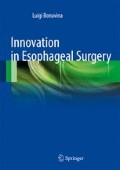Abstract
High resolution esophageal manometry (HRM) provides a detailed analysis of esophageal body peristalsis, upper and lower esophageal sphincter relaxations during deglutition. The novel topographic pressure representations makes HRM interpretation more intuitive and brought a new classification system of esophageal motility abnormalities. To date the most important contribution of HRM is in subclassifying achalasia, the HRM-based subclassification allows to predict outcome to therapy.
Access this chapter
Tax calculation will be finalised at checkout
Purchases are for personal use only
References
Afkari S (2007) Measuring frequency of spontaneous swallowing. Australas Phys Eng Sci Med 30:313–317
Shaheen NJ, Hansen RA, Morgan DR, Gangarosa LM, Ringel Y, Thiny MT, Russo MW, Sandler RS (2006) The burden of gastrointestinal and liver diseases, 2006. Am J Gastroenterol 101:2128–2138
Tack J, Fass R (2004) Review article: approaches to endoscopic-negative reflux disease: part of the GERD spectrum or a unique acid-related disorder? Aliment Pharmacol Ther 19(Suppl 1):28–34
Spechler SJ, Castell DO (2001) Classification of oesophageal motility abnormalities. Gut 49:145–151
Grubel C, Hiscock R, Hebbard G (2008) Value of spatiotemporal representation of manometric data. Clin Gastroenterol Hepatol 6:525–530
Ghosh SK, Pandolfino JE, Rice J, Clarke JO, Kwiatek M, Kahrilas PJ (2007) Impaired deglutitive OGJ relaxation in clinical esophageal manometry: a quantitative analysis of 400 patients and 75 controls. Am J Physiol Gastrointest Liver Physiol 293:G878–G885
Kahrilas PJ, Ghosh SK, Pandolfino JE (2008) Esophageal motility disorders in terms of pressure topography: the Chicago classification. J Clin Gastroenterol 42:627–635
Pandolfino JE, Fox MR, Bredenoord AJ, Kahrilas PJ (2009) Review article: high-resolution manometry in clinical practice: utilizing pressure topography to classify oesophageal motility abnormalities. Neurogastroenterol Motil 21:796–806
Bulsiewicz WJ, Kahrilas PJ, Kwiatek MA, Ghosh SK, Meek A, Pandolfino JE (2009) Esophageal pressure topography criteria indicative of incomplete bolus clearance: a study using high-resolution impedance manometry. Am J Gastroenterol 104:2721–2728
Pandolfino JE, Kwiatek MA, Nealis TJ, Bulsiewicz W, Post J, Kahrilas PJ (2008) Achalasia: it’s not all one disease. Gastroenterology 135:1526–1533
Shay SS, Tutuian R, Sifrim D, Vela MF, Wise JL, Balaji NS, Zhang X, Adhami T, Murray JA, Peters JH, Castell DO (2004) Twenty-four hour ambulatory simultaneous impedance and pH monitoring: a multicenter report of normal values from 60 healthy volunteers. Am J Gastroenterol 99:1037–1043
Zerbib F, des Varannes SB, Roman S, Pouderoux P, Artigue F, Chaput U, Mion F, Caillol F, Verin E, Bommelaer G, Ducrotté P, Galmiche JP, Sifrim D (2005) Normal values and day-to-day variability of 24-h ambulatory oesophageal impedance-pH monitoring in a Belgian-French cohort of healthy subjects. Aliment Pharmacol Ther 22:1011–1021
Zentilin P, Iiritano E, Dulbecco P, Bilardi C, Savarino E, De Conca S, Parodi A, Reglioni S, Vigneri S, Savarino V (2006) Normal values of 24-h ambulatory intraluminal impedance combined with pH-metry in subjects eating a Mediterranean diet. Dig Liver Dis 38:226–232
Vela MF, Camacho-Lobato L, Srinivasan R, Tutuian R, Katz PO, Castell DO (2001) Simultaneous intraesophageal impedance and pH measurement of acid and nonacid gastroesophageal reflux: effect of omeprazole. Gastroenterology 120:1599–1606
Hemmink GJ, Bredenoord AJ, Weusten BL, Monkelbaan JF, Timmer R, Smout AJ (2008) Esophageal pH-impedance monitoring in patients with therapy-resistant reflux symptoms: ‘’on’ or ‘off’ proton pump inhibitor? Am J Gastroenterol 103:2446–2453
Mainie I, Tutuian R, Shay S, Vela M, Zhang X, Sifrim D, Castell DO (2006) Acid and non-acid reflux in patients with persistent symptoms despite acid suppressive therapy: a multicentre study using combined ambulatory impedance-pH monitoring. Gut 55:1398–1402
Zerbib F, Roman S, Ropert A, des Varannes SB, Pouderoux P, Chaput U, Mion F, Vérin E, Galmiche JP, Sifrim D (2006) Esophageal pH-impedance monitoring and symptom analysis in GERD: a study in patients off and on therapy. Am J Gastroenterol 101:1956–1963
Becker V, Bajbouj M, Waller K, Schmid RM, Meining A (2007) Clinical trial: persistent gastro-oesophageal reflux symptoms despite standard therapy with proton pump inhibitors – a follow-up study of intraluminal-impedance guided therapy. Aliment Pharmacol Ther 26:1355–1360
del Genio G, Tolone S, del Genio F, Rossetti G, Brusciano L, Pizza F, Fei L, del Genio A (2008) Total fundoplication controls acid and nonacid reflux: evaluation by pre- and postoperative 24-h pH-multichannel intraluminal impedance. Surg Endosc 22:2518–2523
Frazzoni M, Conigliaro R, Melotti G (2011) Reflux parameters as modified by laparoscopic fundoplication in 40 patients with heartburn/regurgitation persisting despite PPI therapy: a study using impedance-pH monitoring. Dig Dis Sci 56:1099–1106
Savarino E, Zentilin P, Tutuian R, Pohl D, Casa DD, Frazzoni M, Cestari R, Savarino V. The role of nonacid reflux in NERD: lessons learned from impedance-pH monitoring in 150 patients off therapy. Am J Gastroenterol. 2008; 103:2685–93
Author information
Authors and Affiliations
Corresponding author
Editor information
Editors and Affiliations
Rights and permissions
Copyright information
© 2012 Springer-Verlag Italia
About this chapter
Cite this chapter
Hädrich, M., Tutuian, R. (2012). Clinical Impact of High-Resolution Manometry and Impedance-pH Monitoring. In: Bonavina, L. (eds) Innovation in Esophageal Surgery. Springer, Milano. https://doi.org/10.1007/978-88-470-2469-4_2
Download citation
DOI: https://doi.org/10.1007/978-88-470-2469-4_2
Published:
Publisher Name: Springer, Milano
Print ISBN: 978-88-470-2468-7
Online ISBN: 978-88-470-2469-4
eBook Packages: MedicineMedicine (R0)

